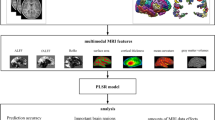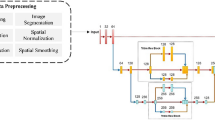Abstract
It is well known that brain development is very fast and complex in the early childhood with age-based neurological and physiological changes of brain structure and function. The brain maturity is an important indicator for evaluating the normal development of children. In this paper, we propose a multimodal regression framework to combine the features from structural magnetic resonance imaging (sMRI) and diffusion tensor imaging (DTI) data for age prediction of children. First, three types of features are extracted from sMRI and DTI data. Second, we propose to combine the sparse coding and Q-Learning for feature selection from each modality. Finally, the ensemble regression is performed by random forest based on proximity measures to fuse multimodal features for age prediction. The proposed method is evaluated on 212 participants, including 76 young children less than 2 years old and 136 children aged from 2-15 years old recruited from Shanghai Children’s Hospital. The results show that integrating multimodal features has achieved the highest accuracies with the root mean squared error (RMSE) of 0.208 years and mean absolute error (MAE) of 0.150 years for age prediction of young children (0-2), and RMSE of 1.666 years and MAE of 1.087 years for older children (2-15). We have shown that the selected features by Q-Learning can consistently improve the prediction accuracy. The comparison of prediction results demonstrates that the proposed method performs better than other competing methods.






Similar content being viewed by others
References
Ball, G., Kelly, C. E., Beare, R., & Seal, M. L. (2021). Individual variation underlying brain age estimates in typical development. NeuroImage, 235, 118036.
Beheshti, I., Mishra, S., Sone, D., Khanna, P., & Matsuda, H. (2020). T1-weighted mri-driven brain age estimation in alzheimer’s disease and parkinson’s disease. Aging and Disease, 11, 618.
Cui, Z., Zhong, S., Xu, P., Gong, G., & He, Y. (2013). Panda: a pipeline toolbox for analyzing brain diffusion images. Frontiers in Human Neuroscience, 7, 42.
Dafflon, J., Pinaya, W. H., Turkheimer, F., Cole, J. H., Leech, R., Harris, M. A., et al. (2020). An automated machine learning approach to predict brain age from cortical anatomical measures. Human Brain Mapping, 41, 3555–3566.
de Lange, A.-M.G., Anatürk, M., Suri, S., Kaufmann, T., Cole, J. H., Griffanti, L., Zsoldos, E., Jensen, D. E., Filippini, N., Singh-Manoux, A., Kivimäki, M., Westlye, L. T., & Ebmeier, K. P. (2020). Multimodal brain-age prediction and cardiovascular risk: The whitehall ii mri sub-study. NeuroImage, 222, 117292.
Fischl, B. (2012). Freesurfer. Neuroimage, 62, 774–781.
Giedd, J. N., Blumenthal, J., Jeffries, N. O., Castellanos, F. X., Liu, H., Zijdenbos, A., Paus, T., Evans, A. C., & Rapoport, J. L. (1999). Brain development during childhood and adolescence: a longitudinal mri study. Nature Neuroscience, 2, 861–863.
Gilmore, J. H., Shi, F., Woolson, S. L., Knickmeyer, R. C., Short, S. J., Lin, W., Zhu, H., Hamer, R. M., Styner, M., & Shen, D. (2012). Longitudinal development of cortical and subcortical gray matter from birth to 2 years. Cerebral Cortex, 22, 2478–2485.
Gray, K. R., Aljabar, P., Heckemann, R. A., Hammers, A., Rueckert, D., Initiative, A. D. N., et al. (2013). Random forest-based similarity measures for multi-modal classification of alzheimer’s disease. NeuroImage, 65, 167–175.
Herting, M. M., & Sowell, E. R. (2017). Puberty and structural brain development in humans. Frontiers in Neuroendocrinology, 44, 122–137.
Holland, D., Chang, L., Ernst, T. M., Curran, M., Buchthal, S. D., Alicata, D., Skranes, J., Johansen, H., Hernandez, A., Yamakawa, R., et al. (2014). Structural growth trajectories and rates of change in the first 3 months of infant brain development. JAMA Neurology, 71, 1266–1274.
Hong, J., Feng, Z., Wang, S.-H., Peet, A., Zhang, Y.-D., Sun, Y., & Yang, M. (2020). Brain age prediction of children using routine brain mr images via deep learning. Frontiers in Neurology, 11.
Huang, J., Zhou, L., Wang, L., & Zhang, D. (2020). Attention-diffusion-bilinear neural network for brain network analysis. IEEE Transactions on Medical Imaging, 39, 2541–2552.
Khundrakpam, B. S., Tohka, J., Evans, A. C., Group, B. D. C. et al. (2015). Prediction of brain maturity based on cortical thickness at different spatial resolutions. Neuroimage, 111, 350–359.
Knudsen, E. I. (2004). Sensitive periods in the development of the brain and behavior. Journal of Cognitive Neuroscience, 16, 1412–1425.
Lan, C., Jing, X.-Y., Li, S., Bian, L.-S., & Yao, Y.-F. (2010). Exploring the natural discriminative information of sparse representation for feature extraction. In 2010 3rd International Congress on Image and Signal Processing (pp. 916–920). IEEE volume 2.
Li, G., Lin, W., Gilmore, J. H., & Shen, D. (2015). Spatial patterns, longitudinal development, and hemispheric asymmetries of cortical thickness in infants from birth to 2 years of age. Journal of Neuroscience, 35, 9150–9162.
Mills, K. L., Goddings, A.-L., Herting, M. M., Meuwese, R., Blakemore, S.-J., Crone, E. A., Dahl, R. E., Güroğlu, B., Raznahan, A., Sowell, E. R., et al. (2016). Structural brain development between childhood and adulthood: Convergence across four longitudinal samples. Neuroimage, 141, 273–281.
Olshausen, B. A., & Field, D. J. (1996). Emergence of simple-cell receptive field properties by learning a sparse code for natural images. Nature, 381, 607–609.
Ouyang, M., Dubois, J., Yu, Q., Mukherjee, P., & Huang, H. (2019). Delineation of early brain development from fetuses to infants with diffusion mri and beyond. Neuroimage, 185, 836–850.
Peng, H., Gong, W., Beckmann, C. F., Vedaldi, A., & Smith, S. M. (2021). Accurate brain age prediction with lightweight deep neural networks. Medical Image Analysis, 68, 101871.
Reznick, J. S. (2009). Working memory in infants and toddlers.
Rokicki, J., Wolfers, T., Nordhøy, W., Tesli, N., Quintana, D. S., Alnæs, D., Richard, G., de Lange, A.-M. G., Lund, M. J., Norbom, L. et al. (2020). Multimodal imaging improves brain age prediction and reveals distinct abnormalities in patients with psychiatric and neurological disorders. Human Brain Mapping.
Sadeg, S., Hamdad, L., Remache, A. R., Karech, M. N., Benatchba, K., & Habbas, Z. (2019). Qbso-fs: A reinforcement learning based bee swarm optimization metaheuristic for feature selection. In International Work-Conference on Artificial Neural Networks (pp. 785–796). Springer.
Shi, F., Wang, L., Gilmore, J. H., Lin, W., & Shen, D. (2011). Learning-based meta-algorithm for mri brain extraction. In International Conference on Medical Image Computing and Computer-Assisted Intervention (pp. 313–321). Springer.
Smith, S. M., Jenkinson, M., Woolrich, M. W., Beckmann, C. F., Behrens, T. E., Johansen-Berg, H., Bannister, P. R., De Luca, M., Drobnjak, I., Flitney, D. E., et al. (2004). Advances in functional and structural mr image analysis and implementation as fsl. Neuroimage, 23, S208–S219.
Smola, A. J., & Schölkopf, B. (2004). A tutorial on support vector regression. Statistics and Computing, 14, 199–222.
Smyser, C. D., Dosenbach, N. U., Smyser, T. A., Snyder, A. Z., Rogers, C. E., Inder, T. E., Schlaggar, B. L., & Neil, J. J. (2016). Prediction of brain maturity in infants using machine-learning algorithms. NeuroImage, 136, 1–9.
Sroufe, L. A. (2005). Attachment and development: A prospective, longitudinal study from birth to adulthood. Attachment & Human Development, 7, 349–367.
Taoudi-Benchekroun, Y., Christiaens, D., Grigorescu, I., Schuh, A., Pietsch, M., Chew, A., Harper, N., Falconer, S., Poppe, T., Hughes, E. et al. (2020). Predicting age and clinical risk from the neonatal connectome. bioRxiv.
Tzourio-Mazoyer, N., Landeau, B., Papathanassiou, D., Crivello, F., Etard, O., Delcroix, N., Mazoyer, B., & Joliot, M. (2002). Automated anatomical labeling of activations in spm using a macroscopic anatomical parcellation of the mni mri single-subject brain. Neuroimage, 15, 273–289.
Walker, L., Chang, L.-C., Nayak, A., Irfanoglu, M. O., Botteron, K. N., McCracken, J., McKinstry, R. C., Rivkin, M. J., Wang, D.-J., Rumsey, J., et al. (2016). The diffusion tensor imaging (dti) component of the nih mri study of normal brain development (pedsdti). Neuroimage, 124, 1125–1130.
Wang, F., Lian, C., Wu, Z., Zhang, H., Li, T., Meng, Y., Wang, L., Lin, W., Shen, D., & Li, G. (2019). Developmental topography of cortical thickness during infancy. Proceedings of the National Academy of Sciences, 116, 15855–15860.
Wang, L., Shi, F., Yap, P.-T., Lin, W., Gilmore, J. H., & Shen, D. (2013). Longitudinally guided level sets for consistent tissue segmentation of neonates. Human Brain Mapping, 34, 956–972.
Watkins, C. J., & Dayan, P. (1992). Q-learning. Machine Learning, 8, 279–292.
Wen, X., Zhang, H., Li, G., Liu, M., Yin, W., Lin, W., Zhang, J., & Shen, D. (2019). First-year development of modules and hubs in infant brain functional networks. Neuroimage, 185, 222–235.
Zöllei, L., Iglesias, J. E., Ou, Y., Grant, P. E., & Fischl, B. (2020). Infant freesurfer: An automated segmentation and surface extraction pipeline for t1-weighted neuroimaging data of infants 0-2 years. Neuroimage, (p. 116946).
Acknowledgements
This study was supported in part by National Natural Science Foundation of China (No.62171283,U19B2035), Natural Science Foundation of Shanghai (20ZR1426300), CAAI-Huawei MindSpore Open Fund, ECNU-SJTU joint grant from the Basic Research Project of Shanghai Science and Technology Commission (No.19JC1410102), Shanghai Jiao Tong University Scientific and Technological Innovation Funds (2019QYB02), Shanghai Municipal Science and Technology Major Project (2021SHZDZX0102).
Author information
Authors and Affiliations
Corresponding authors
Ethics declarations
Ethical Approval
All procedures performed in studies involving human participants were in accordance with the ethical standards of the institutional and/or national research committee and with the 1964 Helsinki declaration and its later amendments or comparable ethical standards.
Informed Consent
Informed consent was obtained from all individual participants included in the study.
Conflicts of Interest
There is no conflict of interest. All authors participated in experiment design, data acquisition and analysis and wrote the manuscript. All approved the final version of the manuscript.
Additional information
Publisher’s Note
Springer Nature remains neutral with regard to jurisdictional claims in published maps and institutional affiliations.
Rights and permissions
Springer Nature or its licensor holds exclusive rights to this article under a publishing agreement with the author(s) or other rightsholder(s); author self-archiving of the accepted manuscript version of this article is solely governed by the terms of such publishing agreement and applicable law.
About this article
Cite this article
Cai, H., Li, A., Yu, G. et al. Brain Age Prediction in Developing Childhood with Multimodal Magnetic Resonance Images. Neuroinform 21, 5–19 (2023). https://doi.org/10.1007/s12021-022-09596-1
Accepted:
Published:
Issue Date:
DOI: https://doi.org/10.1007/s12021-022-09596-1




